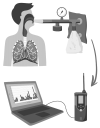Exhaled Biomarkers for Point-of-Care Diagnosis: Recent Advances and New Challenges in Breathomics
- PMID: 36838091
- PMCID: PMC9964519
- DOI: 10.3390/mi14020391
Exhaled Biomarkers for Point-of-Care Diagnosis: Recent Advances and New Challenges in Breathomics
Abstract
Cancers, chronic diseases and respiratory infections are major causes of mortality and present diagnostic and therapeutic challenges for health care. There is an unmet medical need for non-invasive, easy-to-use biomarkers for the early diagnosis, phenotyping, predicting and monitoring of the therapeutic responses of these disorders. Exhaled breath sampling is an attractive choice that has gained attention in recent years. Exhaled nitric oxide measurement used as a predictive biomarker of the response to anti-eosinophil therapy in severe asthma has paved the way for other exhaled breath biomarkers. Advances in laser and nanosensor technologies and spectrometry together with widespread use of algorithms and artificial intelligence have facilitated research on volatile organic compounds and artificial olfaction systems to develop new exhaled biomarkers. We aim to provide an overview of the recent advances in and challenges of exhaled biomarker measurements with an emphasis on the applicability of their measurement as a non-invasive, point-of-care diagnostic and monitoring tool.
Keywords: COVID-19; artificial olfaction system; biosensors; breathomics; electronic nose; exhaled carbon monoxide; exhaled hydrogen sulfide; exhaled nitric oxide; volatile organic compounds.
Conflict of interest statement
The authors declare no conflict of interest. The funders had no role in the design of the study; in the collection, analyses, or interpretation of data; in the writing of the manuscript; or in the decision to publish the results.
Figures


References
Publication types
Grants and funding
LinkOut - more resources
Full Text Sources

